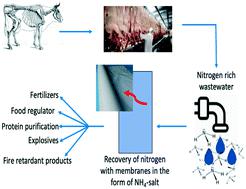当前位置:
X-MOL 学术
›
Environ. Sci.: Water Res. Technol.
›
论文详情
Our official English website, www.x-mol.net, welcomes your
feedback! (Note: you will need to create a separate account there.)
Recovery of viable ammonia–nitrogen products from agricultural slaughterhouse wastewater by membrane contactors: a review
Environmental Science: Water Research & Technology ( IF 3.5 ) Pub Date : 2021-1-4 , DOI: 10.1039/d0ew00960a Brian Brennan 1, 2, 3, 4, 5 , Jenny Lawler 1, 3, 4, 5, 6 , Fiona Regan 1, 2, 3, 4, 5
Environmental Science: Water Research & Technology ( IF 3.5 ) Pub Date : 2021-1-4 , DOI: 10.1039/d0ew00960a Brian Brennan 1, 2, 3, 4, 5 , Jenny Lawler 1, 3, 4, 5, 6 , Fiona Regan 1, 2, 3, 4, 5
Affiliation

|
Efficient removal of nitrogen from wastewater is vital to ensure the safekeeping of waterways and their biota. Increased demand for meat supplies worldwide has led to increased wastewater production consisting of higher nitrogen levels. In order to reduce nitrogen treatment costs using biological denitrification, slaughterhouses need to start looking at the potential of producing by-products from wastewater. The production of viable products from industry-based wastewater has been shown to reduce treatment costs and also generate a source of revenue for the company. The sources of nitrogen in slaughterhouse wastewater are discussed, and the risk it poses to the environment and the different treatment methods are reviewed. Additionally, the need for new methods of ammonia treatment is outlined, including the potential of recovering nitrogen to produce viable products. The use of hydrophobic membranes to recover ammonia from challenging wastewaters is critically analysed and the possible implications it may encounter with slaughterhouse wastewater. The viable products which can be derived from the nitrogen in slaughterhouse wastewater are identified and studies by multiple authors show that the production of ammonium-salts can be used to aid in agricultural fertiliser production, flame retardant compositions, food additives and protein purification precipitation. A comprehensive review of studies evaluating the composition of slaughterhouse wastewater is presented, including the impact of the challenging matrix on membrane materials, which has not being reviewed to date. Additionally, a detailed discussion on how the nitrogen content is recovered using hydrophobic membranes in order to produce viable products is also presented, which has not been discussed before in relation to slaughterhouse wastewater.
中文翻译:

膜接触器从农业屠宰场废水中回收可行的氨氮产品:综述
从废水中有效去除氮对于确保水道及其生物群的安全至关重要。全世界对肉类供应的需求增加导致废水生产增加,其中氮含量更高。为了通过生物反硝化降低氮处理成本,屠宰场需要开始研究利用废水产生副产物的潜力。从工业废水中生产可行的产品已显示出可减少处理成本,并为公司带来收入来源。讨论了屠宰场废水中的氮源,并探讨了其对环境的危害以及不同的处理方法。此外,还概述了对氨处理新方法的需求,包括回收氮以生产可行产品的潜力。严格分析了使用疏水膜从高难度废水中回收氨的方法,以及它对屠宰场废水的可能影响。鉴定了可从屠宰场废水中的氮中提取的可行产物,多位作者的研究表明,铵盐的生产可用于辅助农业化肥生产,阻燃剂组合物,食品添加剂和蛋白质纯化沉淀。介绍了评估屠宰场废水成分的研究的全面综述,包括具有挑战性的基质对膜材料的影响,迄今为止尚未进行综述。另外,
更新日期:2021-01-11
中文翻译:

膜接触器从农业屠宰场废水中回收可行的氨氮产品:综述
从废水中有效去除氮对于确保水道及其生物群的安全至关重要。全世界对肉类供应的需求增加导致废水生产增加,其中氮含量更高。为了通过生物反硝化降低氮处理成本,屠宰场需要开始研究利用废水产生副产物的潜力。从工业废水中生产可行的产品已显示出可减少处理成本,并为公司带来收入来源。讨论了屠宰场废水中的氮源,并探讨了其对环境的危害以及不同的处理方法。此外,还概述了对氨处理新方法的需求,包括回收氮以生产可行产品的潜力。严格分析了使用疏水膜从高难度废水中回收氨的方法,以及它对屠宰场废水的可能影响。鉴定了可从屠宰场废水中的氮中提取的可行产物,多位作者的研究表明,铵盐的生产可用于辅助农业化肥生产,阻燃剂组合物,食品添加剂和蛋白质纯化沉淀。介绍了评估屠宰场废水成分的研究的全面综述,包括具有挑战性的基质对膜材料的影响,迄今为止尚未进行综述。另外,











































 京公网安备 11010802027423号
京公网安备 11010802027423号